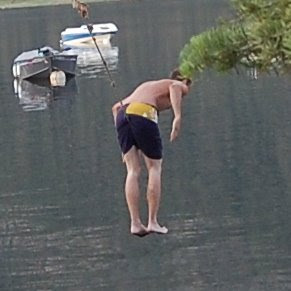
My eldest son is fascinated by leaves and seeds. Since he was wee, he has picked up magnolia leaves and pods on our walk to the library.


 I recently bought a pitch fork to turn our compost pile. It makes it much easier than using a shovel. Everything decomposes fairly fast if you keep it aerated, moist and fed with new green material. Air, moisture and food keeps the microorganisms happy. If you click on the image below you can see that the stuff in the middle is already breaking down after about 4 weeks.
I recently bought a pitch fork to turn our compost pile. It makes it much easier than using a shovel. Everything decomposes fairly fast if you keep it aerated, moist and fed with new green material. Air, moisture and food keeps the microorganisms happy. If you click on the image below you can see that the stuff in the middle is already breaking down after about 4 weeks. When the conditions are right the inside temperature of the pile is very warm - 100 - 140 degrees or so. It feels about the same as washing your hands with hot water. If the pile starts to smell bad it needs more air. The smell will go a way within about 15 minutes of getting air to any stinky spots.
When the conditions are right the inside temperature of the pile is very warm - 100 - 140 degrees or so. It feels about the same as washing your hands with hot water. If the pile starts to smell bad it needs more air. The smell will go a way within about 15 minutes of getting air to any stinky spots.
When adding kitchen scraps I try to add them to a hot area and mix them in a bit. I try to get as much of the new stuff in contact with a warm area as possible. If the new material is scattered too thinly the pile isn't as likely to stay hot. Once it cools off it can be hard to get it going again.

As far as what to add or not add here are a few rules of thumb.
You should not add the following:




 The Anasazi were some of the original American Homesteaders. Their culture evolved from early hunting and gathering to farming the "three sisters" which consist of corn, beans and squash in a symbiotic planting arrangement whereby beans grew up the cornstalks and fixed nitrogen to the soil which the corn required while the squash provided shade the soil which helped retain moisture for all three. This practice is currently part of the permaculture repertoire of gardening techniques.
The Anasazi were some of the original American Homesteaders. Their culture evolved from early hunting and gathering to farming the "three sisters" which consist of corn, beans and squash in a symbiotic planting arrangement whereby beans grew up the cornstalks and fixed nitrogen to the soil which the corn required while the squash provided shade the soil which helped retain moisture for all three. This practice is currently part of the permaculture repertoire of gardening techniques.  Julia snapped a picture of this bee-fly drinking nectar from a flower beside a path while we were visiting Mesa Verde park in Colorado. There were many of the same type buzzing around from flower to flower on the same bush. We thought they were red bumble bees but looking at the photo now it looks more like a fly to me.
Julia snapped a picture of this bee-fly drinking nectar from a flower beside a path while we were visiting Mesa Verde park in Colorado. There were many of the same type buzzing around from flower to flower on the same bush. We thought they were red bumble bees but looking at the photo now it looks more like a fly to me.

















 We are creating quite a catalog of spiders here at Camp Ramshackle. As I was taking the fragments of egg shell from the previous post into the house to get a better picture, I noticed this black widow stretched out on the steps. Pretty unusual. They normally prefer dark corners, wood piles, crawl spaces, etc. Of course this one will have to go.
We are creating quite a catalog of spiders here at Camp Ramshackle. As I was taking the fragments of egg shell from the previous post into the house to get a better picture, I noticed this black widow stretched out on the steps. Pretty unusual. They normally prefer dark corners, wood piles, crawl spaces, etc. Of course this one will have to go.
 We were just in the Four Corners region of the country for about 2 weeks. It was a fantastic trip which I am sure we will post more about soon. While unloading our car, this egg shell must have fallen out of a nest right above us. It landed on the stroller. It looks like it was raided by another bird and dropped over the edge.
We were just in the Four Corners region of the country for about 2 weeks. It was a fantastic trip which I am sure we will post more about soon. While unloading our car, this egg shell must have fallen out of a nest right above us. It landed on the stroller. It looks like it was raided by another bird and dropped over the edge.
 While I was taking pictures the yellow jackets began to home in.
While I was taking pictures the yellow jackets began to home in.









